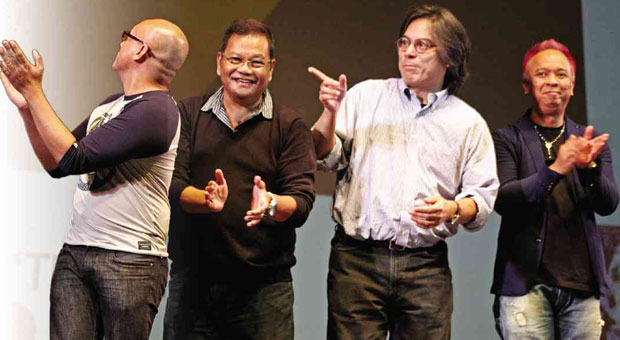
DIRECTORS’ Showcase (from left): Joselito Altarejos, Joel Lamangan, Carlos Siguion-Reyna and Louie Ignacio (Mike Tuviera is the fifth contender).
For the first time in 10 years, the opening ceremony of the Cinemalaya Philippine Independent Film Festival was moved from the Main Theater lobby into the Main Theater.
Spectators had been crammed into the CCP lobby’s modest space for the previous editions’ opening rites. On Friday, guests were seated comfortably in Tanghalang Nicanor Abelardo and got to watch high-definition trailers of the 25 competing films (10 New Breed, 10 Shorts, 5 Directors’ Showcase) on a big screen. (In the past, trailers were projected on flimsy, gauzy white cloth, which distorted the images.)
The move, it might be said, was indicative of the growth of the annual fest’s audience.
As Nes Jardin, president of the Cinemalaya Foundation, pointed out in his welcome address: “From 8,000 people in the inaugural edition … 82,000 watched Cinemalaya films last year.” He said that organizers hoped to attract 90,000 to 100,000 to its main venue (the Cultural Center of the Philippines) and its four satellite locations (Greenbelt, TriNoma, Alabang Town Center and Fairview Terraces) throughout the current festival, which ends Aug. 10.
Jardin had good news: “Over 50 percent of the CCP screenings were sold out [on opening day].”
Going global
Cinemalaya has grown in other ways, as well.
It has gone “international,” for one, with its choice for opening film, Filipino-American journalist Jose Antonio Vargas’ documentary on immigration reform, “Documented.” Vargas’s mother Emelie Salinas, half-siblings Czarina and Carl and several other relatives attended the screening. Salinas received a certificate of recognition for her son, a successful journalist, but undocumented immigrant, in the United States.
NEW BREED filmmakers (from left): Janice O’Hara, GB Sampedro, Nick Olanka, Milo Sogueco, Ida Anita del Mundo, Giancarlo Abrahan, Derick Cabrido, Francis Xavier Pasion, Real S. Florido and Gino M. Santos.
“It was overwhelming to hear and see people’s reactions,” said Salinas’ daughter. “I first watched it online,” Salinas said. “This was my first time to see it on the big screen, with an audience.”
The closing film, “A Thief, A Kid & A Killer,” is directed by Korean-American filmmaker Nathan Adolfson and top-billed by Filipino actors Epy Quizon, Lance Raymundo and Felix Roco.
The Hollywood Foreign Press Association (HFPA, which hands out the annual Golden Globes) presented an award to Cinemalaya organizers—led by foundation chair Antonio “Tonyboy” Cojuangco and competition chair Laurice Guillen.
Globes race
- CINEMALAYA chair Tonyboy Cojuangco attended Friday’s rites with partner Gretchen Barretto.